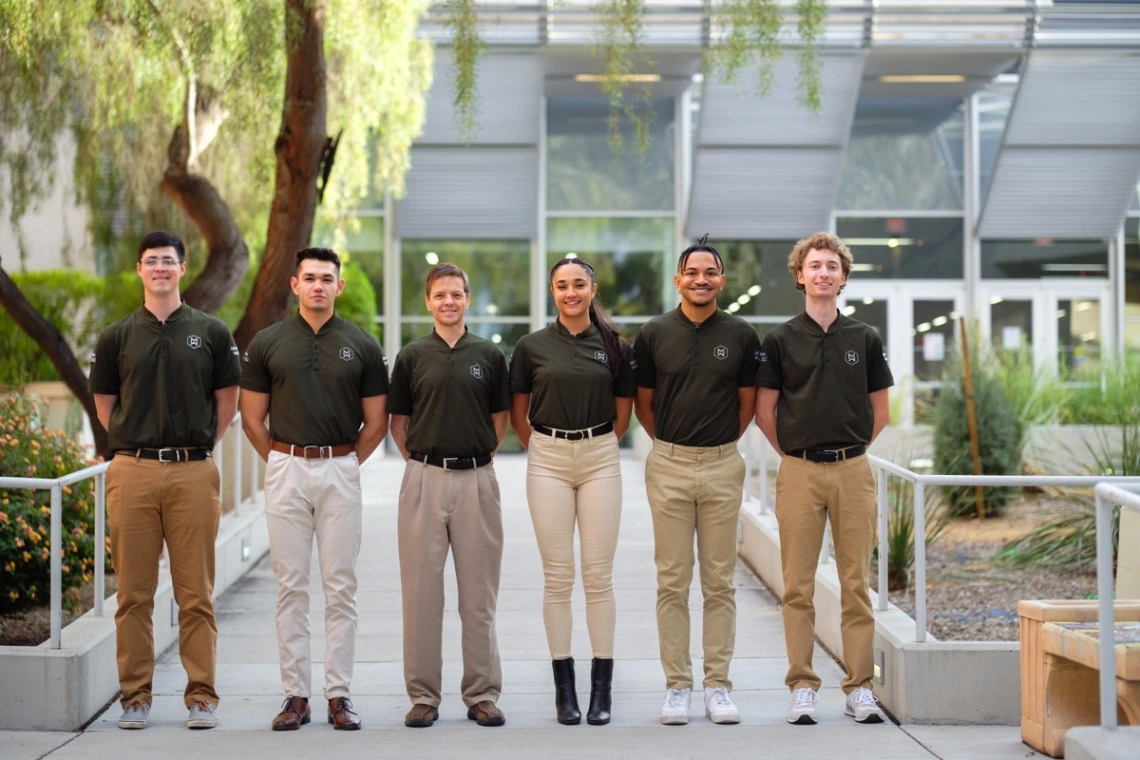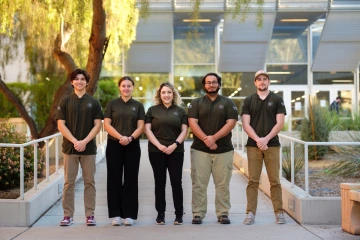Startups and Student Design Teams: A Win-Win Combination

Team 23075 is working with Microentities Worlwide.
Multiple projects at the 2023 Craig M. Berge Design Day combine engineering and a startup mindset, thanks to a grant from the Technology and Research Initiative Fund, which is overseen by Research, Innovation and Impact at the University of Arizona.
College of Engineering leaders used part of an experiential learning allocation from TRIF to bring local startups into the Interdisciplinary Capstone projects as sponsors for the 2022-2023 academic year. That support is allowing engineering students to work directly with the companies on projects ranging from lightning-protective clothing to sustainable building materials to animal-tracking devices. Some of the TRIF funding was also used to set up the new Engineering Design Center.
Mark Van Dyke, associate dean of research in the College of Engineering, describes the situation as a win-win, for startups that may lack sponsorship capital and students in need of real-world experience.
“Startup culture is totally different from large corporate America. Students get to see more of the operations of a company. For engineering students this is really important because a lot of times they are deep into the engineering aspect of it and may not see the larger context of a business or product development,” Van Dyke said. “Being close to that is a lot easier in a smaller company.”
The College of Engineering worked with Tech Launch Arizona and the Arizona Technology Council to partner with local startup companies. Tech Launch Arizona was helpful with setting up agreements that worked for both the university and the companies, said Van Dyke.
“As a hub for the commercialization ecosystem, one of our goals is to be a connector, bringing together university startup teams with outside resources,” said Paul Tumarkin, assistant director of marketing and communications for Tech Launch Arizona.
The Land Rower and the Animal Tracker
Microentities Worlwide is sponsoring two projects through the program. With the “Land Rower,” Interdisciplinary Capstone team 23075 is intended to learning the parts of an innovation project, how they work together, and what they need to succeed.
The team is combining mechanical and biomedical engineering to create a prototype trike that is powered by rowing mechanics. The device should travel across flat ground, accommodate a person up to 300 pounds, and be able to turn without the rider needing to pause their rowing motion.
“This really helps drive the understanding that the goal of an innovation project is to experiment and deliver value,” said project sponsor Ben Blehm. “This involves more than technical work, but also contracting, suppliers, deciding the risk, reward and scope and a variety of other ideas. Work is also typically poorly defined, so a large part of a project is understanding what the customer wants.”

Team 23070
Capstone Team 23070 is creating a miniature device that tracks the health of animals. Inspired by a friend who works with horses, Microentities Worldwide project advisor Daniel O’Connor envisions a prototype that can work with both pets and agricultural animals. The devices are intended to monitor location and heart rate, while also having a battery life of more than four weeks and costing less than $10 each. Finally, they are designed to operate in conjunction with a phone app that reads out data.
“The students may learn about these topics in the classroom, but they get to apply these principles and flex their skills when they are working on one of our projects,” O’Connor said. “Ultimately, this allows the students to be better prepared for their first jobs in industry.”
O’Connor says this real-world application teaches students the product development process and everything that it involves: product definition, trade-off studies, design implementation, root cause analysis and system integration. They also need to take into account business principles such as balancing scope, timeline and budget.
“Utilizing the UA senior design program to help develop initial prototypes has been extremely valuable,” O’Connor said. “I would highly recommend this approach for other small businesses who are looking to develop early prototypes at an affordable price.”

